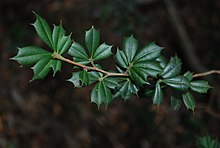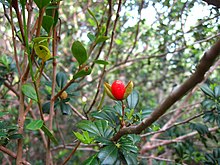Trichilia triacantha, the bariaco,[3] is a species of plant in the Meliaceae family endemic to Puerto Rico.
| Trichilia triacantha | |
|---|---|

| |

| |
| Trichilia triacantha fruit | |
| Scientific classification | |
| Kingdom: | Plantae |
| Clade: | Tracheophytes |
| Clade: | Angiosperms |
| Clade: | Eudicots |
| Clade: | Rosids |
| Order: | Sapindales |
| Family: | Meliaceae |
| Genus: | Trichilia |
| Species: | T. triacantha
|
| Binomial name | |
| Trichilia triacantha | |
Description
editThe bariaco is a shrub or a tree reaching up to 9 meters tall. It has leaves made up of several leathery, spine-toothed leaflets and the flowers are white.[4] The fruit is a capsule with a red aril.[5]
Habitat
editThe plant grows in dry forest habitat on limestone substrates, often near intermittent streams.[4]
Conservation
editAs of 2007 there were 10 populations of the tree containing a total of 109 individuals. 47 of these were found to be fertile. Six of the ten populations were located in the Guánica National Forest. Two of these were composed of single individuals located several kilometers from other members of the species, and so are unlikely to reproduce.[5]
This plant has been overharvested because its wood is useful and attractive.[4] It is additionally threatened by habitat loss, and as such is a federally listed endangered species of the United States.
References
edit- ^ World Conservation Monitoring Centre (1998). "Trichilia triacantha". IUCN Red List of Threatened Species. 1998: e.T30969A9596129. doi:10.2305/IUCN.UK.1998.RLTS.T30969A9596129.en. Retrieved 17 November 2021.
- ^ "Trichilia triacantha. NatureServe Explorer 2.0". explorer.natureserve.org. Retrieved 4 August 2023.
- ^ NRCS. "Trichilia triacantha". PLANTS Database. United States Department of Agriculture (USDA). Retrieved 14 December 2015.
- ^ a b c USFWS. Determination of Endangered Status for the Plant Trichilia triacantha (Bariaco). Federal Register February 5, 1988.
- ^ a b Ventosa-Febles, E. A. (2007). Distribution and habitat characteristics of Trichilia triacantha (Meliaceae) in Puerto Rico. Endanger Species Res 3 267-71.

